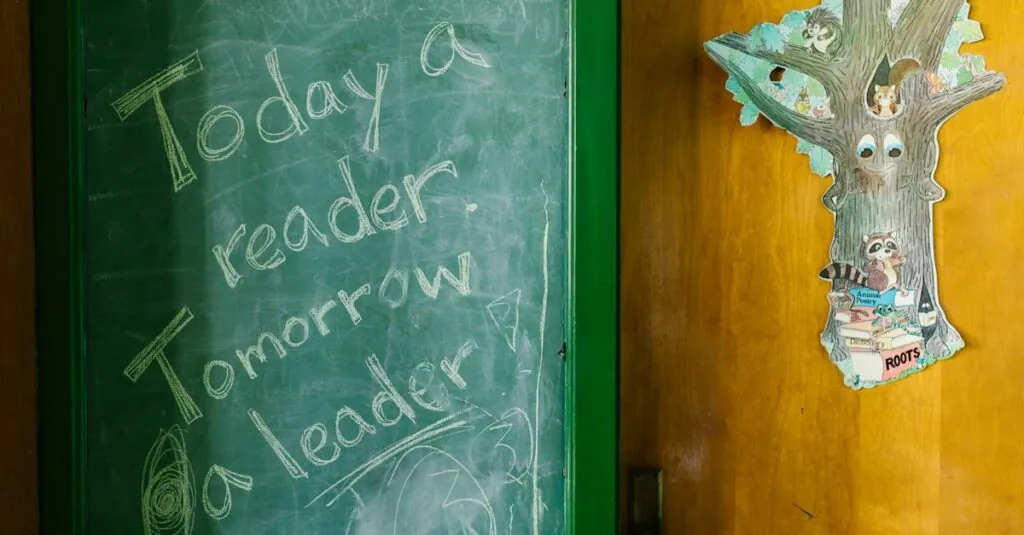Table of Contents
ToggleEducation today faces a wild mix of challenges that could make even the most seasoned teachers pull their hair out. From outdated curricula that feel like they belong in a museum to the ever-growing divide in access to technology, the classroom landscape is changing faster than a student can say “pop quiz.”
Overview of Current Educational Landscape
Challenges in education impact students, educators, and the learning environment. Outdated curricula fail to align with the skills required in today’s job market, hindering students’ preparedness for future careers. Educators often find themselves overwhelmed by rapid changes, complicating lesson planning and implementation.
Access to technology illustrates significant disparity among students. While some schools benefit from cutting-edge tools, others struggle with outdated equipment, widening the learning gap. Data shows that 30% of low-income households lack adequate internet access, limiting opportunities for online learning and resources.
Teacher shortages create additional obstacles within classrooms. Many educators face burnout, particularly in high-demand subjects like math and science. Schools must prioritize recruitment and retention strategies, focusing on providing competitive salaries and beneficial working conditions.
Mental health issues among students contribute to the evolving educational landscape. Nearly 20% of youth experience mental health challenges, impacting their academic performance and overall wellbeing. Schools should implement programs fostering emotional support and resilience to better address these needs.
Lastly, evolving educational policies complicate the landscape further. Changes at federal and state levels impact funding, accountability, and instructional methods. Navigating these regulations requires constant adaptation and vigilance from educational institutions.
Addressing these issues demands comprehensive approaches, leveraging collaboration among educators, policymakers, and communities to improve the educational experience for all students.
Key Issues in Education Today
Current issues in education significantly impact student learning and teacher effectiveness. Addressing funding inequities and resource allocation remains critical.
Funding and Resource Allocation
Funding disparities affect educational outcomes. Public schools serving low-income communities often receive less financial support, exacerbating resource shortages. For instance, research shows that these schools frequently lack basic supplies, technology, and qualified staff. Effective resource allocation is vital for closing achievement gaps that persist across different socioeconomic groups. A focused investment in educational resources can help ensure that all students receive equitable opportunities to succeed.
Teacher Shortages and Retention
Teacher shortages have reached alarming levels. Recent data indicates that over 20% of teachers leave the profession within their first five years. This turnover disproportionately affects high-demand subjects like math and science, straining schools further. Ineffective working conditions, including inadequate salaries and high-stress environments, contribute to these challenges. Retaining effective educators requires addressing workload, providing professional development opportunities, and fostering a supportive school culture.
Curriculum Relevance and Standardization
Curriculum relevance plays a crucial role in student engagement. Outdated curricula often fail to reflect contemporary skills or societal needs, leading to disengaged learners. Standardization can hinder creativity and individualized instruction, making it challenging for teachers to adapt to students’ unique needs. Incorporating diverse perspectives and current topics into curricula promotes a more dynamic learning environment. Continuous evaluation and adaptation of educational standards ensure that curricula remain relevant and meaningful for all students.
Impact of Technology on Education
Technology significantly influences education today, providing both opportunities and challenges. Integration of digital tools enhances learning experiences while presenting hurdles that educators and students must navigate.
Advantages of Technology Integration
Technology integration offers numerous benefits for learners. Engagement levels increase as interactive platforms and multimedia resources promote active participation. Personalized learning becomes feasible, allowing educators to tailor content based on individual student needs. Access to vast online resources supports research and fosters critical thinking. Data-driven insights help educators identify areas requiring improvement, enabling targeted interventions. With tech tools, collaboration among students expands beyond classroom walls, encouraging teamwork and communication skills.
Challenges of Digital Divide
Unequal access to technology remains a pressing issue in education. Around 30% of low-income households lack adequate internet connections, restricting opportunities for online learning. Disparities in technology access create significant barriers, leading to achievement gaps among students. Students without reliable access face difficulties completing assignments and engaging in remote learning. These challenges further exacerbate existing inequalities in education. Bridging this digital divide requires concerted efforts from policymakers, schools, and communities to ensure all students have equitable access to essential technology.
Special Education and Inclusion
Special education faces significant challenges in today’s educational landscape. Inclusion strategies in classrooms are often inconsistent, leading to varied experiences for students with disabilities. Teachers may lack adequate training and resources, which directly impacts their ability to support diverse learners effectively.
Classroom sizes frequently hinder personalized attention needed for students with special needs. Many educators note that individualized education programs (IEPs) can be complex and time-consuming to implement. These hurdles contribute to disparities in educational outcomes, especially for those requiring specialized support.
Funding inequities further complicate special education services. Schools in low-income communities often struggle to allocate sufficient resources for effective inclusion practices. According to recent studies, up to 80% of families with children in special education report inadequate access to necessary services, adding urgency to this issue.
Access to appropriate interventions and support varies widely across different regions. Many schools lack essential staff, such as special education teachers and aides, which limits the effectiveness of inclusion efforts. Data reveals that about 20% of special education students do not receive the necessary accommodations mandated by law, leading to feelings of inadequacy and frustration.
Parental involvement is crucial but may vary significantly. Encouraging active participation from parents can foster a better understanding of their child’s needs. Collaborative partnerships between schools and families often enhance educational experiences for students with disabilities.
Efforts to improve special education and inclusion require systemic changes. Promoting awareness and training among educators can empower them to meet diverse needs effectively. Prioritizing equitable resource distribution and support systems will significantly enhance the educational experiences of all students, particularly those with disabilities.
Addressing Socioeconomic Disparities
Educators face significant challenges when addressing socioeconomic disparities in education. Public schools in low-income communities often lack adequate funding, which directly impacts the resources available for students. About 30% of low-income households do not have reliable internet access, limiting opportunities for online learning and engagement. Such disparities contribute to achievement gaps and hinder student performance.
Additionally, schools in affluent areas usually have more funding and resources. This inequity in resource allocation affects teacher retention, with over 20% of teachers leaving the profession within their first five years. Supporting educators in low-income districts is crucial to maintain stability and provide consistent learning experiences.
Special education services also encounter disparities, as many underfunded schools struggle to meet the needs of students with disabilities. A staggering 80% of families with children in special education report inadequate access to essential services. Such a lack of resources complicates educators’ efforts to create inclusive environments and meet the diverse needs of students.
Collaboration among educators, policymakers, and communities proves essential in tackling these issues. Enhanced parental involvement can strengthen support networks for students, providing additional resources and assistance. Fostering partnerships between schools and families promotes a more inclusive educational experience.
Schools must prioritize equitable resource distribution to close achievement gaps across socioeconomic backgrounds. Systemic changes in funding allocations, along with targeted support and training for educators, lead to significant improvements in educational outcomes. Addressing these socioeconomic disparities requires commitment and persistent effort from all stakeholders involved.
The challenges in today’s education system are complex and multifaceted. Addressing outdated curricula and disparities in technology access is essential for creating an equitable learning environment. Teacher retention and burnout must be tackled to ensure that students receive the support they need.
Mental health considerations also play a crucial role in student success and wellbeing. Furthermore, funding inequities continue to hinder resource allocation in low-income communities.
To foster meaningful change, collaboration among educators, policymakers, and families is vital. By prioritizing equitable resource distribution and systemic reforms, stakeholders can work together to enhance educational experiences and outcomes for all students.







